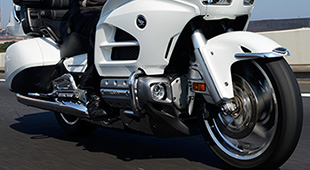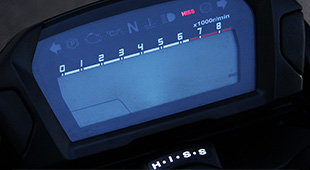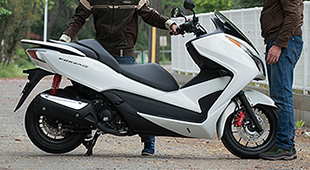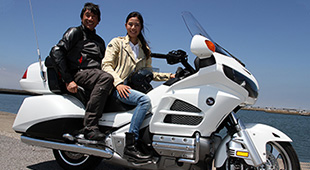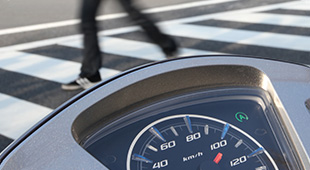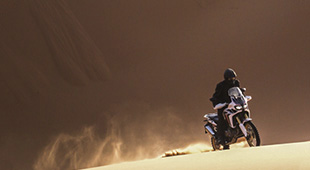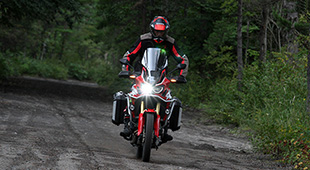Tech Views — Vol.1 Dual Clutch Transmission
X-ADV (Dual Clutch Transmission)

X-ADV (Dual Clutch Transmission)
The existence of DCT made the X-ADV concept possible.
The X-ADV looks a lot like a heavy-duty scooter, so my first reaction to this totally new vehicle was "What on earth is this new X-ADV?" I simply couldn' work it out. It brought to mind the early four-wheel drive cars that came out long before the term 'SUV', which were ruggedly built to conquer a host of terrains. Those cars were well liked by active drivers who enjoyed weekends outdoors, and the X-ADV reminded me of their strength, fun and dependability, which opened up a whole new world of driving enjoyment.
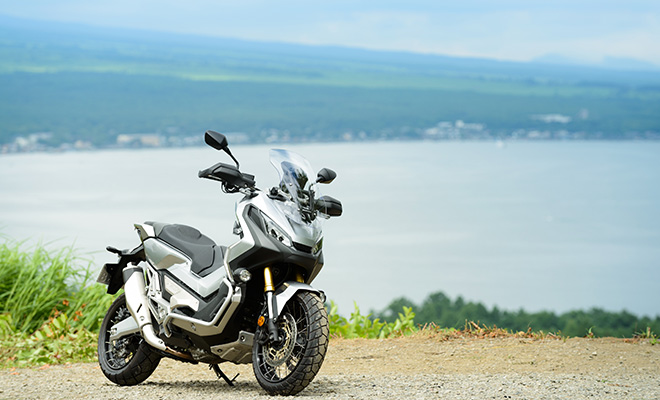
What makes the X-ADV especially exciting are its wire-spoked wheels and long-travel suspension travel, which give the impression that it's been built to tear up the dirt. In true off-road style, its exhaust system has an upward pointing silencer, a functional multi-position windscreen, a rectangular instrument panel and more...
As soon as I could, I jumped right on to check out this nicely designed 'wild one' and to find answers to my initial question, "What on earth is this new X-ADV?"
Before getting into the review, let's take another look at the DCT system. The letters DCT stand for Dual Clutch Transmission, which is a system that combines an almost conventional gearbox with an electronically controlled automatic gear-change system that further broadens the appeal of riding by not requiring manual clutch operation. Although DCT systems have already become well-known devices on cars, to install a DCT system on a motorcycle, with its limited available space, and to devise a shifting program that can appeal to riders who are used to manual transmissions, could only be made possible by Honda's highly advanced technology.
With the DCT system physically performing all the clutch work and shifting, you're relieved of any worries about stalling the engine when letting out the clutch, or possibly missing a shift. Starting on slopes is also problem-free, and when riding two-up, normal up and down shifts are often smoother than the manual shifts of many expert riders. The first time I rode a DCT model I was shocked to realize how distracted I'd been by the constant operation of the clutch and gears when using a manual gearbox. I've been riding for more than 30 years now, and have always strived to be a better rider, but the DCT seriously hurt my pride.
By surrendering control to the DCT and freeing myself from the tasks of clutch work and gear-shifting, I experienced a peculiar feeling. I suddenly found I was better able to focus on throttle control and precise braking, which resulted in a more relaxed state of mind that allowed me to be more aware of other traffic and pedestrians. Also, when riding beyond the crush of city traffic I was able to enjoy the scenery a lot more than I could on a manual transmission bike. The DCT filled my ride with a richness and pleasure that I'd never appreciated before.
Although the DCT system offers a stress-free ride, it's still a 6-speed gearbox, and I was delighted to find that shifting up and down resulted in the same exhaust note and feel of engine vibration that you get with a manual transmission. Another thing I noticed was that because I didn' have to constantly position myself to operate the clutch or gear shift pedal, cornering became a lot easier.
Some journalist once described the DCT as an 'aggressive' system, and now I understand what he meant. I would further describe it as a mechanism that makes riding a motorcycle more enjoyable.
Incorporating the latest update of this DCT system, the X-ADV is now standing right in front of me. What is this new riding machine going to be like? Throwing a leg over feels effortless, a sensation that has a lot in common with conventional scooters. But when sitting down on the seat and reaching forward to grab the handlebars, that scooter sensation quickly disappears, instead giving the impression of a totally new type of motorcycle.
Equipped with a smart key, starting the X-ADV requires only turning the ignition switch and pushing the starter button while gripping the front brake lever. This up-to-date starting procedure and the strong pulse of the engine that followed filled me with a feeling that I was about to experience something totally new and powerful.
After choosing 'D' (Drive) mode via the selector switch on the right-side handlebar and then kicking up the sidestand, just a twist of the throttle got things moving. As the engine poured out its pulsating exhaust note, the clutch hooked up smoothly and the take-off was impressive. Much like the NC750 series, there's plenty of low-rev torque, propelling the X-ADV to a quick start off the line with only the slightest twist of the throttle, and feeling a lot more like a motorcycle than a scooter.
With the CVT (Continuously Variable Transmission) systems commonly used on scooters, engine revs tend rise to a certain point and stay there while the scooter accelerates. The feeling that the clutch is slipping for a long period gives the impression that machine's actual speed is continually trying to catch up.
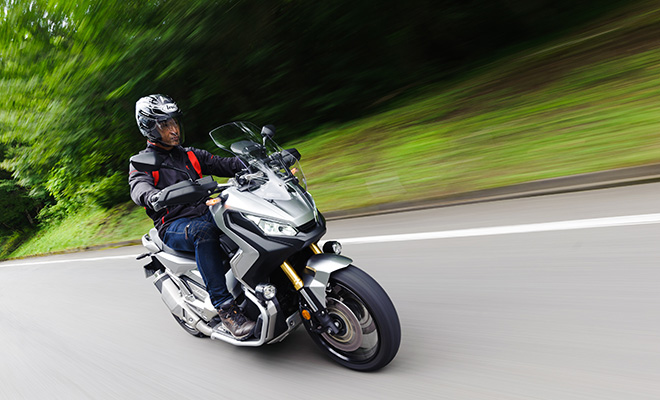
In contrast, around town the X-ADV's DCT system automatically changes gears to keep engine revs within its strongest range of around 2500rpm, as if the rider is shifting in response to riding conditions. And while simply set to its automatic 'D' mode, the DCT responds like it totally understands what the rider is doing, feeling all the world like a manual transmission.
Although some riders with long years of experience riding motorcycles with manual transmissions may have issues with an automatic, they should really have a go on a DCT bike like the X-ADV. Although it changes gears automatically, the DCT's acceleration is very much like that of a manual gearbox, so it doesn' feel the least bit strange or uncomfortable—once you get used to not having a clutch lever to grab or shift lever to push up and down.
Besides its user-friendly 'D' mode, the X-ADV's DCT also has an 'S' mode which can be set to any of three different shift timing patterns. Out of this total of four automatic shift modes, you're sure to find a shift timing to your liking. Personally, I preferred the standard 'D' mode, which shifts at lower rpms, making the most of the engine's low-rev torque characteristics.
Another pleasant discovery was finding that the X-ADV's rear brake lever was located on the left-side handlebar, in place of its missing clutch lever. Although this makes it more like a scooter, when considering ride characteristics this seemed to be a good idea.
After an hour's ride around town, I ventured up onto the motorway. Accelerating from an on-ramp into the flow of cars at speed can require some care at times, but the X-ADV lets you concentrate on its powerful acceleration while monitoring the interval between the cars reflected in its rearview mirror. The DCT allows you to use the full power of the 750cc engine with comfort and precise control, letting the X-ADV show its power and grace when slipping into the fast flow of motorway traffic. Suspension settings were also well matched to the character of the DCT, and provided a quality ride both in town and out on the open road.
An hour's ride west on the motorway took me into the hills, where touring friendly twisty roads await. Operating both the front and rear brakes with my hands, I pressed on the 'down' shift button to keep the revs high for good acceleration out of the corners. To keep the revs up in such situations, the 'S' mode is the one to choose. This mode has three shift schedules, which you can chose according to your liking or the type of road you're planning to ride. If that's not enough and you'd like to be even more in control of the gears, the 'M' (Manual) mode lets you operate the Up (+) and Down (–) shift buttons on the left-side handlebar. This provides a feel remarkably close to that of a manual gear box—just without the manually operated clutch lever—and all gears are literally at your fingertips.
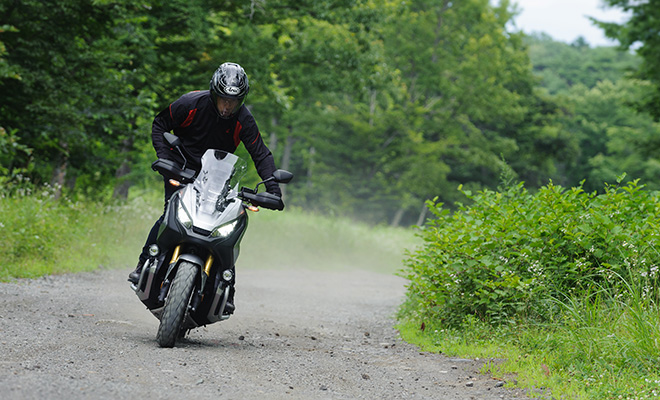
After trying out the various modes, I settled for 'D' and used the down shift switch whenever I wanted some engine braking. This way of using the DCT matched the type of riding I wanted to do, and gave me even more confidence in my control of the X-ADV. All proving how good the DCT shift program is.
So, what do you think? Starting to get interesting, no?
The reason I was able to become so 'close' with the X-ADV is that its riding feel is so positive, making it easy to bring out the bike's full character and performance, and making time spent on it exciting and richly rewarding. Feeling adventurous, I took an unpaved route with beautiful scenery to further explore the X-ADV's capabilities.
Turning off onto a dirt road, things soon got really fun. The X-ADV's low center of gravity provided a reassuring sense of stability and a ride that turned out to be exactly what I was looking for. Even in normally tenuous situations like starting out on loose dirt, I felt totally in control and was able to stay calm thanks to the machine's predictable throttle response and how the engine's pulsating low-rpm torque was transmitted to the ground via the rear wheel. Feedback to the rider was also excellent, making it easy to tell if I was kicking up gravel, if the rear wheel was slipping or if it was slowly and gently gripping the road surface.
Response to the opening and closing of the throttle is amazingly precise, instantly transmitting the engine's output as you'd imagine, directly to the rear wheel, much like a manual transmission, which is a big advantage of the DCT. And with no feeling of time-lag in its operation, you're able to concentrate more on the ride.
That is to say, the X-ADV allowed me to more thoroughly enjoy the experience of riding. Whether accelerating, decelerating or cornering, I had a feeling of almost direct connection between my right hand and the rear wheel, which could be instantly controlled with a simple twist of the throttle. On top of this, on the dirt it made it easier to bring out the essential qualities of both the bike and its engine.
Decelerating is another thing the DCT handles well. Just touch the Down (–) shift switch and engine braking is applied to the rear wheel. The smooth and gentle way the clutch engages as it does this is absolutely superb. And with no need to operate a manual clutch, it frees the rider's left hand, arm and shoulder of any related tension. Similar to CVT bikes, clutch operation is unnecessary, but the direct feel of the DCT is superb, offering the benefits of enhanced handling as it smoothly delivers a more natural ride.
I found that one of the biggest benefits of the DCT is how it allows you to get the most out of the bike's handling due to its more relaxed riding position. I realize now that when riding a motorcycle, the constant operation of the clutch lever occupies the rider's mind and physical movement in innumerable ways.
Also, I found that in spite of the X-ADV's sizeable build, I was better able to relaxeven riding on dirt roads—and enjoy the scenery more, and felt sure that this was due to the capabilities of the DCT system.
After spending an entire day on the X-ADV, my conclusion is that this vehicle conveys the image of an adventure bike, letting you ride almost anywhere or any way you want. In other words, the DCT system plays an important role in relieving riders of the small 'pressures' of clutch operation, giving you the full confidence that you can go anywhere on virtually any road.
This X-ADV obviously would not have been possible without its DCT. The DCT system has also continued to evolve, and is now a new feature that determines the riding character of every motorcycle that has the good fortune to be equipped with it.
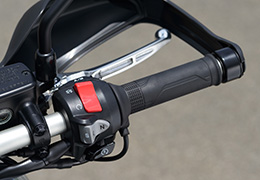
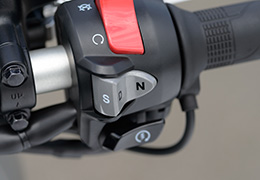
The DCT shift/mode select switch is located on the right-side handlebar. The gray switch marked 'S/D/N' is used to change shift modes. The Auto/Manual selector switch is positioned on the other side, in front of the red kill switch. Normally, after starting the engine, the rider shifts the gray button to 'D', putting the transmission into Auto shift mode. The rider can then choose Auto or Manual modes by tapping the forward-positioned switch with the right index finger.

When choosing Manual shift mode, the Up (+) and Down (–) shift buttons located on the left-side handlebar can be used to select the desired gear. These two buttons can also be used to change gears in 'D' or 'S' modes.
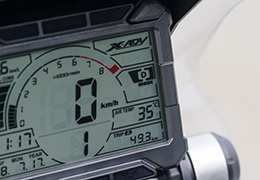
The 'D' on the right side of the instrument panel indicates that the DCT is in 'Drive' mode and ready to go. The large '0' in the center shows vehicle speed and the '1' beneath it is the gear position.

The mode can be shifted to 'S' by pressing the gray shift/mode selector switch again. The 'S' mode allows the engine to rev higher in each gear. Any of three modes within the 'S' mode can also be selected by holding down the shift switch. The dark blocks to the left of the 'S' display show that the DCT is in the second 'S' mode.
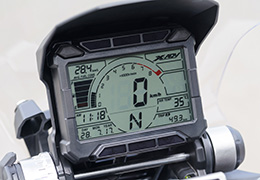
The 'N' at the bottom of the instrument panel indicates that the transmission is in Neutral. The DCT always automatically shifts back to Neutral when the engine is stopped or the ignition switch is turned on.
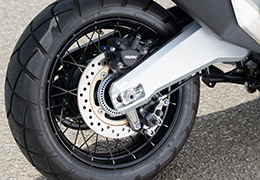
Because all DCT models stay in Neutral when the engine is stopped, the rear brake is equipped with an additional parking brake.
TRANSMISSION TECHNOLOGIES - DUAL CLUTCH TRANSMISSION -
Honda has developed a motorcycle transmission with automated clutch and shift operation that delivers the same riding enjoyment as a manual transmission.

